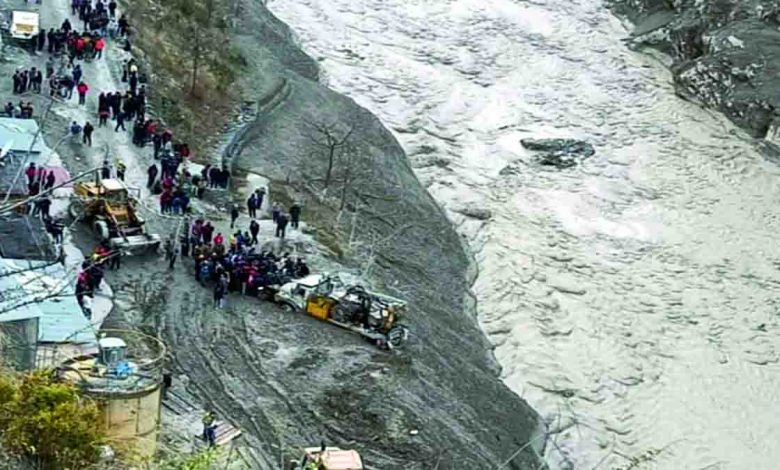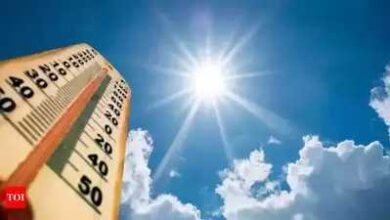U’khand avalanche: Many theories, no certain reason!

There is no clarity so far on the reasons for the glacier burst and the resultant avalanche and flash floods that wreaked havoc in the upper reaches of the Himalayas in Uttarakhand on Sunday, but experts have zeroed in global warming or Western disturbance as the possible causes for the melting of the snow and breaking of the glacier that could have triggered the inundation in Chamoli district.
The Snow and Avalanche Study Establishment (SASE) of the Defence Research and Development Organisation is investigating the tragedy, but there are no clear answers yet for a glacier to have melted in the winter.
It is not clear whether the flood is a typical Glacial Lake Outburst Flood (GLOF) or some temporary damming due to a landslide and avalanche that might have blocked the mainstream to form a temporary lake which burst, said Ranjit Rath, Director General of the Geological Survey of India (GSI).
A GLOF is a type of outburst flood that occurs when the dam containing a glacial lake fails.
“Once the water level recedes a team of experts will assess the damage as well as the triggering factor responsible for the outburst,” Rath told reporters here.
As the nightmare envisaged by numerous environmentalists warning against untrammelled development in the mountains came true on Sunday, glaciologist Farooq Azam said a glacial burst is very rare.
“We have been trying to understand the event since yesterday. Right now what we can tell is a glacier slipped from around 500-600 metres, which started a landslide with an icefall that triggered this disaster,” Azam, Assistant Professor, Glaciology & Hydrology, Indian Institute of Technology, Indore, told a news agency.
“For sure there was no glacial lake outburst flood, for sure there is no cloud burst because there is no lake available in the region at this particular time. Even if there are lakes, they are frozen and they don’t have any activity. The disaster happened because of an icefall and landslide.” he added.
Satellite and Google Earth images, Azam added, do not show a glacial lake near the region, but there’s a possibility there may be a water pocket in the region.
“Water pockets are lakes inside the glaciers, which may have erupted leading to this event,” he said. He suggested further analysis of weather reports and data to confirm if this indeed was the case. Climate scientist Roxy Mathew Koll agreed and also said more data are needed. He said the recent climate change assessment report for India shows significant melting and decline in glacier mass over the Himalayan region in the recent decades due to warmer temperatures.
Koll also said it was not clear if an accumulation of glacier melt led to this burst, and noted that Western disturbances during last week did bring in a lot of snow over the region, followed by clear sky and warm temperatures.
“It is quite possible that climate change and melting of fresh snow led to piling up of water in this area,” Koll, scientist at the Indian Institute of Tropical Meteorology (IITM) in Pune said.
The Intergovernmental Panel on Climate Change (IPCC)’s Special Report on Oceans and Cryosphere in a Changing Climate (SROCC) also shows that climate change has altered the frequency and magnitude of natural hazards. “The scientists reported with medium confidence that in some regions snow avalanches involving wet snow have increased while the rain on snow floods have also increased at lower elevations in springs,” Prakash, lead author of the ongoing 6th Assessment report of IPCC, said in a statement.
“The vulnerabilities are exacerbated by climate change with risks of glacial lake outbursts,” Pema Gyamtsho, Director General of the International Centre for Integrated Mountain Development (ICIMOD), the Kathmandu-based inter-governmental knowledge centre, said on Monday.
“Across the globe, so many people have seen visuals of or heard about the flooding event. The visuals are frightening and heartbreaking. This is once again a grave reminder about how our shared mountain region is fragile and vulnerable to a multitude of geological and natural processes. And it is a grave reminder that vulnerabilities are exacerbated by climate change,” Gyamtsho said in a statement.
“Those glaciers provide important water storage, but when warming across the globe is accelerated, there are changes in water flows and risks of glacial lake outburst events,” Gyamtsho said.
He added that this is an important moment for the Hindu Kush Himalaya (HKH) countries to pause and reconsider development in the mountains given the emerging risks posed by climate change.
“While we need infrastructure and other projects to ensure the lives and livelihoods of mountain communities, we also need to look at ways of development that consider the fragility of these areas, recognise the inherent risks, and the implications of cascading effects on downstream areas.
“It is with this understanding and sense of urgency that, together with our member Governments, we have issued an HKH Call to Action, outlining concrete actions at the local, national and regional levels to address issues critical to our HKH mountains,” he added.
Tuesday, 09 February 2021 | PNS | New Delhi





